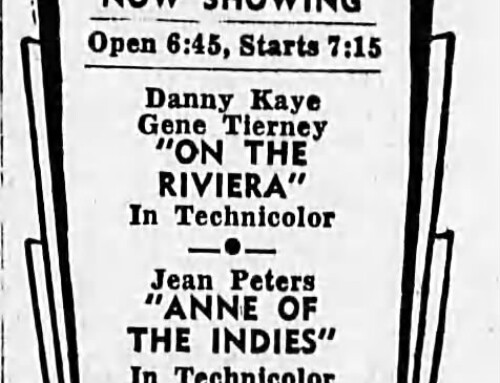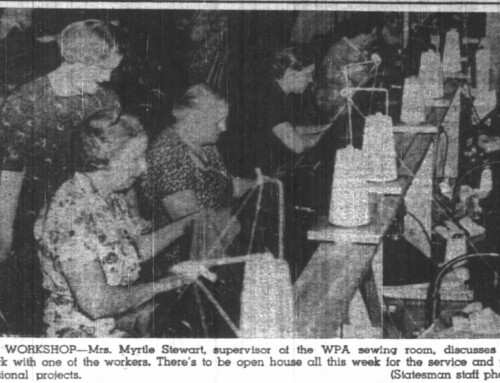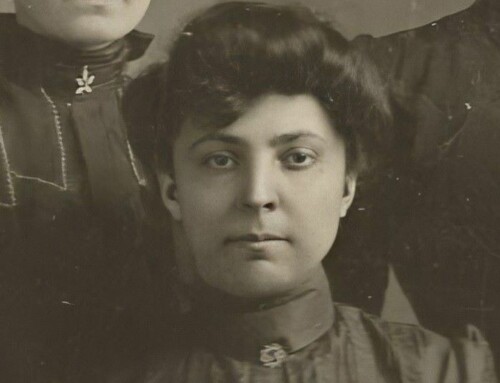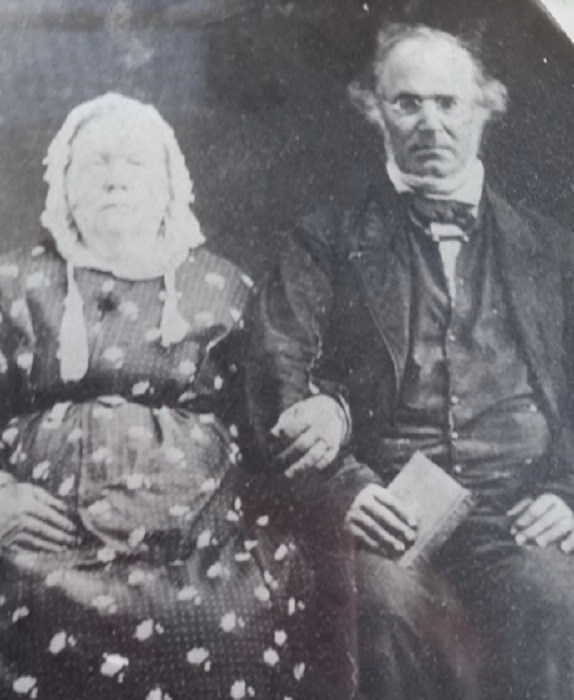
Neill and Esther Johnson, Belpassi pioneers. Used with permission MGB Family Tree, Ancestry.com
It was late August 1851, a miserably wet and muddy day on the Barlow road near the summit of Laurel Hill when Oregon pioneer Neill Johnson made a decision that would affect not just his family’s future, but the course of a town in northern Marion County. Provisions were low and animals suffering the effects of the arduous journey. Leaving his two older boys with the weaker cattle, heavy wagons and a few pounds of flour, Neill took the three strongest oxen and started down Laurel Hill with his wife, 5 daughters and 3 children. He hoped to get them to the safety of Philip Foster Farm and then go back for the boys. The group made their way down the trail crossing the Zig Zag river several times, but eventually found themselves marooned by the rising water.
According to the journal of Neill’s son John Lawrence, help came in the form of a stranger on horseback, an old gentleman named Mr. Craft who hailed from “near Salem.” When he learned that Neill Johnson was a Cumberland Presbyterian preacher he said, “I am acquainted with some of the members of that church and will hurry home, report and they will send help. If you need any money, I have some with me and will let you have what you want and you can pay me some time in the future if able, if not all right.”
The group continued their journey to safety and within a few days were met at the Foster farm by William A. Jack and Thomas B. Allen with the help promised by Mr. Craft. The two men brought two yoke of fresh oxen and a variety of provisions. With their help, Neill was able to go back for his boys, livestock and wagons. Jack and Allen encouraged the family to consider settling in the French Prairie area. Out of gratitude or perhaps a sense of duty or responsibility, the Johnson family did, buying a half section of land south of what would eventually become the city of Woodburn. Neill Johnson became the preacher of the local congregation of Cumberland Presbyterians and along with his boys built the church that would also serve as the first school building of the community.
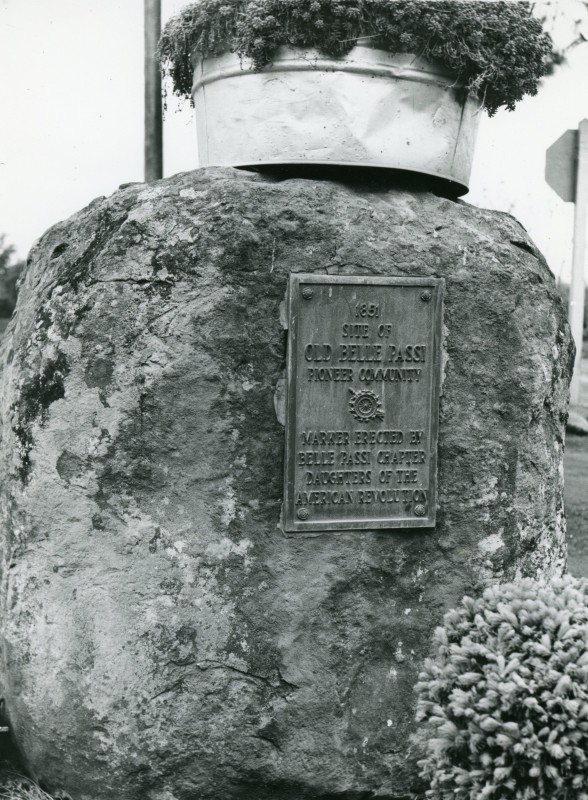
DAR marker placed at the site of the former city of Belle Passi. WHC 2011.001.0012a
Within a few years the community decided they needed a post office, which meant choosing and officially registering a name for their small town. They approached Neill Johnson for a suggestion. Drawing inspiration from the theological book he was reading at the time, he suggested Belpassi after the Italian city of Belpasso. The spelling would alter over time to Belpasse and later Belle Passi due in part to a local chapter of the Daughters of the American Revolution and a monument placed to mark the site of the town. Belle Passi in Italian translates to “beautiful walk”.
The town lay on the overland stage route between Salem and Oregon City. And during its prime years 1850-1870s was considered one of the main towns in Marion County, predating Gervais and Woodburn. In a Capital Journal article dated April 10, 1947 Mrs. Carrie Young, born in Belpassi in 1855, recalled a general store owned by Robert Hanna that supplied nails and calicos. She also remembered the Cumberland Presbyterian meetinghouse that also served as a school. The upper floor of the building was occupied for a time by an academy taught by E.P. Henderson of Eugene. It boasted an impressive library of 100 volumes. In this building the Washington Literary Society was organized.
In the Pacific Christian Advocate dated March 5, 1864, we read a description of a celebration held by the society. “The anniversary of Washington’s birthday was celebrated at Belpassi. It was a memorable day, and worthily was it employed. From 10 o’clock a.m., until 12 o’clock at midnight…five hundred people remained patiently and delightedly, their patriotism finding new inspiration from the passive exercises“.
Back to Mrs. Young’s memories of the town. A temperance organization known as The Templars had lodge here. And the town did have a doctor, a water doctor. “He prescribed no pills for his patients but, instead, wrapped them in bedclothes and saturated the bundle with hot water”. She also shared the origin story of the Belpassi cemetery. In 1851 a stranger in attendance at one of Neill Johnson’s church services suddenly died. Nothing was known about the man except that his name might be William Eaton. Several church members stepped forward and offered a site for a community cemetery in which to bury the stranger. The cemetery remains to this day, one of the few reminders of the former town.
During Civil War times Belpassi was a Union stronghold. So strong were their union sympathies that in addition to forming a Union League under General Joel Palmer in February 1864 they followed up with a petition to Governor Addison C. Gibbs in 1866 requesting that the legislature be called into special session to ratify the Thirteenth Amendment to abolish slavery based on their perception that former Confederate Army soldiers were emigrating to Oregon in large numbers.
Their concern dated back to the election of November 1864 when a sharp increase in population was noticed in the number of votes cast for the Democratic candidate for president. Most of the new arrivals were southern sympathizers from Missouri many of whom had deserted the Confederate army. Alarmed citizens feared the balance of power in the legislature would shift back to the pro-slavery Democrats. Governor Gibbs would go ahead and call the special session, the Thirteenth Amendment would be ratified by both chambers, but not without opposition.
After the railroad came to Woodburn in 1870, the town rapidly declined. Within a year the town went from three businesses, 40 homes, a school, post office, cemetery and population of 188 according to the 1870 census, to a ghost town. The Cumberland Presbyterian church moved to Woodburn and Robert Hanna moved his store to Gervais. Few remnants of Neill Johnson’s pioneer hamlet are still visible as you travel 99E north to Woodburn. The church and school site marked by a DAR marker and of course, the cemetery where Johnson and his family are buried.
This article was written by Kaylyn F. Mabey for the Statesman Journal where it was printed 16 September 2018. It is reproduced here with sources for reference purposes.
Sources:
- “Enthusiastic Union Meeting at Belpassi, Marion County”, Weekly Oregonian, 25 May 1861, p. 2
- “Ghost Towns of Marion County”, Capital Journal, 10 Apr 1947, p. 15
- “Ghost Town Cemetery Stirs Up Gun Fight Memories”, Capital Journal, 5 July 1969, p. 27
- Scott Account of traveling the Oregon Trail “Bits for Breakfast”, R.J. Hendricks, Oregon Statesman, 19-21 Jan 1940.
- Interview conducted by Sara B. Wrenn on January 11, 1939. Informant was Miss Jean C. Slausen of Lake Grove, Oregon, Oregon Folklore Studies, Federal Writers’ Project WPA, Library of Congress website
- Marion County History, Marion County Historical Society, Vol. 1, p. 6
- Marion County History, Marion County Historical Society, Vol. 3, p. 47-48
- Marion County History, Marion County Historical Society, Vol. 7, p. 22
- Early Schools of Marion County, Marion County Historical Society, p. 61-62
- “As Time Goes By” Woodburn Independent, 16 Aug 1969, p. 6-7, 10




